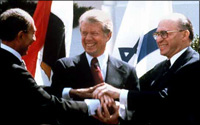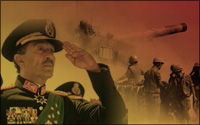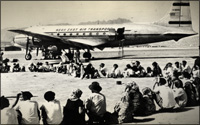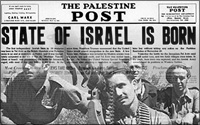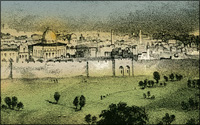 The return of the Jewish people to the Land of Israel is arguably the dominant theme of Jewish history for the past 150 years.
The return of the Jewish people to the Land of Israel is arguably the dominant theme of Jewish history for the past 150 years.
The return itself will take very strange forms and the cast of characters is quite varied. Since we are still in the midst of the story it is difficult to assess all of the ramifications. Nevertheless, the story is fascinating – and not just for the Jewish people. The State of Israel, small and relatively powerless as it is, has become a very central issue in world politics and occupies a very disproportionate space in the media as well as the minds and pocketbooks of the world. It remains a central a central drama that proves fascinating to all.
Hastening the Messiah
There always a Jewish presence in the Land of Israel, but it was relatively small from the year 500 CE until modern times. In fact, from 500 to 1500 CE the Jewish population can be numbered in the hundreds of people. The Jewish presence in Palestine was not really strengthened until the middle of the 1500s when the exiles from Spain arrived and established centers of learning in Safed and Jerusalem. From that time until the time we are discussing now most the Jews there were Sefardic. The Ashkenazic Jews had almost no presence whatsoever.
However, the modern rebirth of Jewish life in the Land of Israel begins with Ashkenazic immigration in the 1700s. And it began from two almost diametrically opposed camps: the Chassidim and their “opponents,” the Misnagdim. Nevertheless, both were motivated by the same religious and mystical impulse, which, simply put, was that one could force the Messiah to come.
The founder of Chassidim, the Baal Shem Tov, wanted very badly to come to Israel, but was stopped. “From heaven” they stopped him, he said. There is a famous legend that along the way he was set upon by robbers and he told them that if they would help him get to the Land of Israel he would give them a share of his portion in the World to Come. In any event, the pressure to bring the Messiah was part and parcel of the growth of Chassidism, and the pious leaders of the generation were the ones who had the power to force God’s hand.
Early Settlers
As a practical matter, the Baal Shem Tov never made it to the Land of Israel. However, his brother-in-law, Rabbi Gershon Kitover, did in 1742. In 1753, we find Rabbi Kitover in Jerusalem founding the first Ashkenazic community there.
Together with the Chassidim, the disciples of the Gaon of Vilna came, including two of his primary disciples, Rabbi Menachem of Shklov and Rabbi Israel of Shklov, who were brothers. They came with many students, disciples and families. Even though the Chassidim and the followers of the Vilna Gaon, the Misnagdim, did not get along with each other in Europe they found the wherewithal to unite and make a single, strong Ashkenazic community in the Land of Israel.
The Ashkenazim settled in Safed, Tiberius, Hebron and Jerusalem. In Hebron it was mainly a Chassidic community. In Safed there was a strong community of the Vilna Gaon’s disciples under Rabbi Israel of Shklov. However, in 1816 there was a tremendous cholera epidemic and then an earthquake which destroyed the city. Even today one can see the fault lines in the old cemetery of Safed; it moved 12-15 yards. Hundreds of people were killed, decimating the community. Most of the Jews there moved to either Tiberius or Jerusalem.
A Law Book of Agriculture
Rabbi Israel of Shklov wrote one of the great books that helped developed the Land of Israel, Paas HaShulchan. It is a code of Jewish law regarding agriculture, i.e. how to farm in the Land of Israel.
When in the 1500s Rabbi Joseph Caro wrote his seminal book on Jewish law, the Shulchan Aruch, he did not include agricultural laws, because those laws applied only in the Land of Israel and there were no Jewish farmers at that time. A handful of scholars knew the laws from the Talmud and sources, but other than them these laws were largely unstudied. Rabbi Israel of Shklov changed that. His work was immediately recognized as an epic of scholarship, and all later works in this area of Jewish law were based upon it.
In his introduction, Rabbi Israel of Shklov describes what he calls “the pains of settling in the Land of Israel.” The Talmud long before said that a person cannot hope to settle in the Land of Israel unless he is willing pay a price. Rabbi Israel describes some of the personal tragedies he experienced settling there.
During the cholera epidemic his wife and all the children except one daughter died. The surviving daughter was subsequently killed in the earthquake. He literally lost everything and was forced to flee even without his manuscripts.
He eventually came to Jerusalem and resettled there, drawing on his deep wellsprings of faith to strengthen himself against the terrible tragedies that had been visited upon him. He writes that after all his suffering he was finally beginning to see a glimmer of the greatness and holiness of the land. Nevertheless, his introduction about “the pains – i.e. the costs — of settling in the Land of Israel” is a classic unto itself.
Today’s Israel bears little or no resemblance to the land that these early pioneers found. There were no trees in the country. It was rocks and swamp lands. Just about every tree one sees today was hand-planted.
Even clearing the land of rocks to prepare it for planting was herculean. Early pioneers told how before they went through the back-breaking labor of plowing and planting they did nothing but pick up rocks for a couple of years.
Those were the pioneers. The generation that came before them, like Rabbi Israel of Shklov and his compatriots, had even more unimaginable obstacles to deal with. They did not even have trains journeying from Europe to the Land of Israel in those days. And if one was Jewish there was the added danger of persecution from non-Jews. Then, if they made it, they had to face the ordeal of settling in an entirely different climate and deal with disease and unfriendly Arabs.
Yet, these European Jews came and settled. Their tenacity, love of the land and faith enabled them to establish a foothold in the country. Everything that Jews have today in Israel is built from that foothold.
Beginnings of New Jerusalem
Sir Moses Montefiore came to Palestine in 1839 and bought land right outside the walls of the Old City. Arab marauders made it unsafe for Jews to go out at night. People were reluctant to move out of the Old City. Even though apartments were built the danger was so real that people would go to the new city outside the walls during the day, but at night they would return to sleep within the Old City walls.
Since Jerusalem was under the control of the Ottoman Turks, there were no policemen for the Jews to appeal to. Therefore, it was not until 1872 that a group of seven young families agreed to buy land outside the walls and actually sleep there at night. That neighborhood is called Nachlat Shiva, “the inheritance of the seven.” It was the beginning of the New Jerusalem.
These first Jews lived there isolated and alone outside the protection of the city walls under a government that offered them no protection. Nevertheless, the historic fact is that Jews came and built a strong Jewish presence in a country is a testament to their determination and incredible sacrifices.
Economic Support
God has arranged things such that Jews living in the Land of Israel cannot support themselves. They have to seek outside help and charity. It was that way during certain epochs in Second-Temple times, during the Middle Ages and the last 150 or more years since Jews started resettling their ancient homeland.
Jewish leaders set up a special fund to support Jews in the Land of Israel called Kupas Rabbi Meir Baal HaNess, “The Fund of Rabbi Meir the Miracle Worker.” People went all over Europe to collect money for this all-encompassing fund.
In European countries this fund was entirely illegal. In Russia, for instance, it was forbidden to send any money out of the country or even collect it for that purpose. Even worse was collecting it to be sent to Palestine, which was under Turkish rule; the Turks and the Russians were frequently at war with each other or on the verge of war. Therefore, all the rabbis who participated – and almost all the major rabbis in Eastern Europe did participate in the fund – were liable to immediate arrest.
Nevertheless, this fund – which still exists today – was fabulously successful. Money arrived regularly. It is how the Jewish community survived.
Lovers of Zion
Beginning in the 1860s a new idea came into the Jewish world in Eastern Europe, Hovevei Tzion, “The Lovers of Zion.”
It was not as much an official organization as a mass movement among the Jewish people. The idea was to promote Jewish immigration to Palestine and make Jews self-sufficient there, i.e. to give them the wherewithal to not live on charity funds alone.
The Lovers of Zion were a strange mixed of people. They included pious and great rabbis as well as radical, atheistic Jews. It began as a religious movement steeped in Jewish tradition and belief, even though many of the participants were not religious Jews.
The religious philosopher of the movement was a German rabbi named Zvi Hirsch Kalischer (1795-1874). He was joined by other great rabbis, including the famous leader of the yeshiva in Volozhin, Rabbi Naftali Yehuda Zvi Berlin, the “Netziv.” These people were leaders of the Lovers of Zion movement and gave it a religious character.
However, there was another stream that flowed into the Lovers of Zion, the secularists. Two books were written at the time which advanced the secular stream and became progenitors of political, secular Zionism.
The first was written by a German Jewish philosopher named Moses Hess entitled Rome and Jerusalem. He was not referring to the Rome of the Roman Empire but the Rome of his time, in the 1850s. Hess was not religious and had very little Jewish background or even any idea what Judaism was about. Nevertheless, his idea was to build a Jewish state patterned upon the Italy of his time, which had just united after centuries of disunity. He wanted Jews to march into Palestine and take it over.
The second book was written by Leon (Yehudah Leib) Pinsker and called Auto Emancipation. By the title he meant that the Jewish people could free themselves — and the vehicle for their own self-freedom was colonization of the Land of Israel.
These two books were secular. They did not take any religious Jewish experience into account. But combined with the religious leadership of the rabbis these factors galvanized the Lovers of Zion movement and made it a strong reality, pushing Jews toward colonization.
Edmond Rothschild
The final piece of the puzzle known as the Lovers of Zion was another great character in Jewish history, Baron Edmond Rothschild (1845–1934). He was a traditional Jew. Rather than letting philanthropic opportunities come to him he went looking for them.
One day, a great rabbi convinced him that he should focus his efforts on the resettlement of the Jews in Palestine, and this became his life work.
In his moral last will and testament, he wrote that he thanks the Almighty for giving him the privilege of participating in helping the Jewish people return to their ancient homeland and allowed him to begin to see the fruits of his labors.
Baron Edmond Rothschild was the key to the success of the Lovers of Zion movement. He bought the land and brought the business, including the founding of the Carmel Wine Company, which he gave to the farmers.
The original towns that now are the oldest cities in modern Israel were either financed by him, encouraged by him or created because he created other towns.
To Baron Edmond Rothschild, resettling the land for the Jews was not just a hobby, but a mission that he was driven by. He is the final link in the picture of the Lovers of Zion. It originated with the rabbis, was joined by the secularists and finally fueled by the money, help and talents of Baron Rothschild.

